Resuscitation is a critical lifesaving technique used to revive someone from unconsciousness or apparent death due to cardiac arrest. This guide will cover essential resuscitation methods, including performing CPR, when to use it, and age-specific techniques. Understanding and applying these techniques promptly can significantly increase the chances of survival.
Key Takeaways
Cardiopulmonary resuscitation (CPR) is a critical technique combining chest compressions and artificial ventilation to maintain brain function and blood circulation in individuals experiencing cardiac arrest. The core principle involves a 30:2 ratio of compressions to breaths.
CPR techniques vary by age. For adults, the emphasis is on chest compression depth and rate. In children, compression depth and hand placement are adjusted. For infants, specific techniques include using two fingers for chest compressions and appropriate head positioning for rescue breaths.
Technological advancements, such as mechanical chest compression devices and mobile apps, improve CPR quality by providing consistent compressions and real-time guidance. These tools help maintain proper technique and increase the chances of survival during cardiac emergencies.
Understanding Cardiopulmonary Resuscitation (CPR)
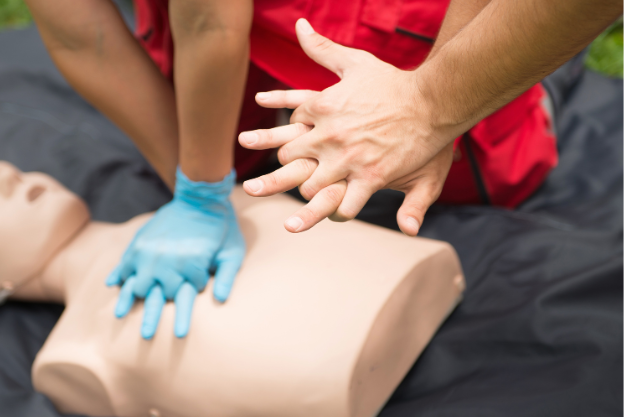
Anyone experiencing cardiac arrest can potentially be saved by the lifesaving technique of cardiopulmonary resuscitation (CPR). It involves a combination of chest compressions and artificial ventilation to manually preserve brain function until further measures can restore spontaneous blood circulation and breathing in a person in cardiac arrest. The method combines rescue breathing (mouth-to-mouth) and chest compressions to pump blood to the brain until specialized treatment is available.
CPR must be performed promptly to be effective, ideally within six minutes after blood flow stops. This urgency is due to the brain’s vulnerability to oxygen deprivation, which can lead to irreversible damage within minutes. The term “resuscitation” was first known to be used in the 1950s, and since then, CPR techniques have evolved significantly.
The core principle of CPR is the 30:2 ratio: 30 chest compressions followed by 2 rescue breaths. Chest compressions are the priority because they help maintain blood flow to vital organs, even if rescue breathing is not possible. Ventilation techniques can include mouth-to-mouth and bag-valve-mask (BVM) methods.
Both in-hospital and out-of-hospital cardiac arrests necessitate CPR, with the chain of survival remaining the same in either scenario. The steps involved in CPR are often remembered using mnemonics like C-A-B (compressions, airway, breathing) or DRSABCD (Danger, Response, Send for help, Airway, Breathing, Compressions, Defibrillation). The most crucial step remains performing high-quality chest compressions, and healthcare providers should ensure all components of CPR—compressions, airway, and breathing—are performed effectively.
When to Perform CPR
In emergency situations, it’s vital to know when to perform cardiopulmonary resuscitation (CPR). CPR should be administered to an unresponsive individual who is not breathing normally or only gasping. This abnormal breathing, often referred to as agonal gasps, is a critical indicator of cardiac arrest and may even resemble apparent death.
Before initiating CPR, ensure that you check for a pulse for at least 5-10 seconds. If no pulse is detected, immediate action is required. The urgency of CPR in these moments cannot be overstated, as early and effective CPR, coupled with early defibrillation, significantly increases the chances of survival in out-of-hospital cardiac arrest cases.
In scenarios where a person collapses suddenly, CPR should be initiated immediately after calling for emergency assistance. For unwitnessed collapses, especially in children and infants, it’s recommended to perform two minutes of CPR before seeking emergency help if alone. This ensures that the victim receives critical intervention during the crucial initial moments.
CPR is also necessary in specific situations, such as drowning or trauma. In cases of drowning, CPR should be administered as soon as the victim is pulled from the water. Similarly, during trauma incidents like severe injuries, CPR should be initiated if there are no signs of life and no pulse.
Overall, CPR should be started for any victim who is unresponsive, not breathing normally, and shows no signs of life. The promptness of these actions can double or even triple the chances of survival when bystanders take quick and effective action.
CPR Techniques for Different Age Groups
Due to anatomical and physiological differences, CPR techniques should be tailored to suit different age groups. While the fundamental principles of cardiopulmonary resuscitation (CPR) remain consistent, the application varies for adults, children, and infants to ensure effectiveness and safety.
For CPR, the techniques vary depending on the age group:
-
For adults, the focus is on a 30:2 compression-to-breath ratio with proper hand placement and depth.
-
In children, adjustments are made for compression depth and hand placement, ensuring that CPR is performed effectively without causing harm.
-
Infant CPR requires even more specific techniques, including using two fingers for compressions and maintaining proper head positioning.
Gripping these variations is indispensable for anyone performing CPR, whether a healthcare provider or a bystander. The following subsections provide detailed guidance on CPR techniques tailored for adults, children, and infants.
Adult CPR
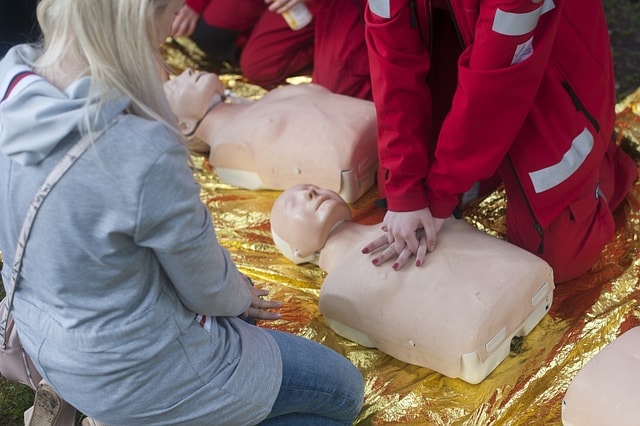
When performing CPR on an adult, the guidelines recommend following the CAB sequence: chest compressions, airway, and breathing. Start by checking for a pulse and, if none is detected, begin chest compressions immediately. The recommended number of compressions is 30, followed by 2 rescue breaths, maintaining a 30:2 ratio.
Proper hand placement is critical. Here are the steps to follow:
-
Place the heel of one hand on the center of the patient’s chest, just below the nipple line.
-
Place the other hand on top.
-
Interlock your fingers and keep your elbows straight to use your body weight for compressions.
-
The compression depth should be between 2 and 2.4 inches, pushing hard enough to generate sufficient blood flow.
For effective CPR, it’s necessary to:
-
Sustain a consistent compression rate of 100 to 120 compressions per minute
-
Minimize interruptions and continue compressions until advanced help arrives or the patient shows signs of recovery
-
If an automated external defibrillator (AED) is available, use it as soon as possible to provide a shock to the heart if necessary.
In emergency scenarios, such as sudden cardiac arrest or ventricular fibrillation, timely and high-quality CPR, combined with defibrillation, can significantly improve the chances of survival. Therefore, it is crucial to act swiftly and confidently when performing CPR on adults.
Child CPR
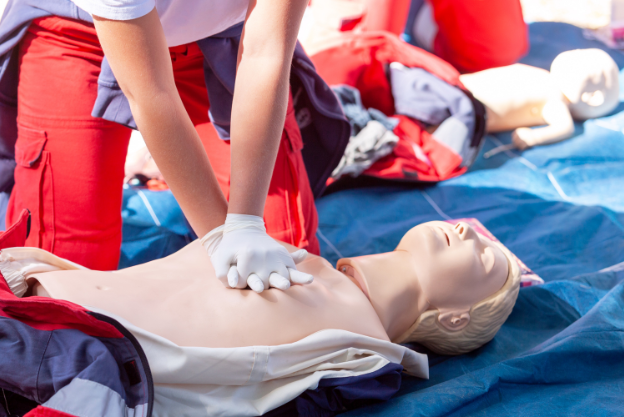
Child CPR requires modifications to account for their smaller size and different physiological needs. The compression depth for children should be around 1.5 to 2 inches, or approximately 1/3 the anterior-posterior dimension of the chest. Depending on the child’s size, you may use one or both hands for compressions.
Follow the same CAB sequence as for adults but with adjustments in technique. Begin by opening the child’s airway using the head-tilt, chin-lift maneuver. This ensures the airway is clear, allowing for effective rescue breaths. Perform mouth-to-mouth breathing, ensuring a proper seal over the child’s mouth and nose.
The compression-to-rescue breath ratio remains the same at 30:2. Ensure compressions are delivered at a rate of 100 to 120 per minute, with minimal interruptions. In cases where a rescuer is alone and encounters an unconscious child, it is recommended to perform two minutes of CPR before calling for emergency medical services.
Child CPR is often required in scenarios such as drowning, choking, or sudden illness. It is crucial to remain calm and follow the recommended steps to provide effective care. Proper training and regular practice can help ensure that rescuers are prepared to respond appropriately in these critical situations.
Infant CPR
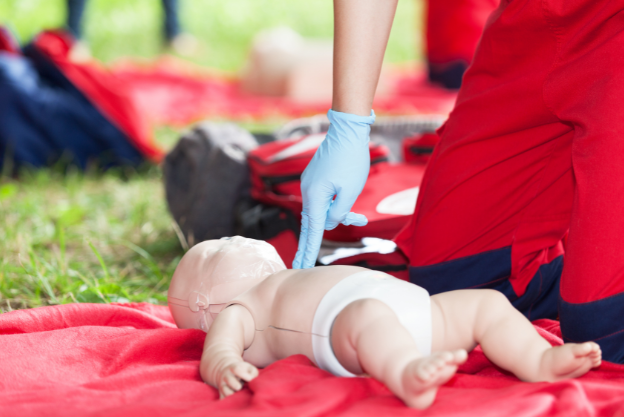
Infant CPR involves specific techniques to accommodate their delicate physiology. For babies under the age of 1, excluding newborns up to 4 weeks old, follow the CAB method tailored to infants. Use two fingers for chest compressions, placing them on the center of the chest just below the nipple line. The compression depth should be around 1.5 inches, ensuring gentle but effective compressions.
The infant’s head should be positioned in the ‘sniffing position’ to open the airway for rescue breaths. Ensure a proper seal over the infant’s mouth and nose and deliver gentle breaths, watching for chest rise. The compression-to-breath ratio remains 30:2, with compressions delivered at a rate of 100 to 120 per minute.
If alone with an infant, start CPR immediately before calling emergency services. This ensures the infant receives critical intervention without delay. Infant CPR is often required in cases of respiratory distress, choking, or sudden illness, making it essential for caregivers and parents to be well-versed in these techniques.
By understanding and practicing these age-specific CPR techniques, rescuers can provide effective and lifesaving care to individuals of all ages.
High-Quality CPR
High-quality CPR is the cornerstone of effective resuscitation efforts. To ensure CPR is as effective as possible, it is crucial to maintain a consistent compression rate of 100 to 120 compressions per minute. Additionally, the depth of chest compressions should be between 2.0 and 2.4 inches for adults. These parameters help maximize blood flow to the brain and other vital organs.
Maintaining a high chest compression fraction, ideally above 80%, is vital. This means minimizing interruptions in compressions, as each pause can significantly reduce the likelihood of survival. Techniques to maintain high-quality compressions include:
-
Swapping providers every two minutes to prevent fatigue
-
Using a metronome to keep the correct rhythm
-
Utilizing CPR feedback devices that monitor compression quality
It is equally important to avoid excessive ventilation during CPR. Overventilating can increase intrathoracic pressure, reducing venous return to the heart and thus decreasing cardiac output. Properly timed rescue breaths, delivered at a steady rate, help maintain the balance needed for effective resuscitation.
Visual monitoring and continuous training are essential to ensure healthcare professionals and lay rescuers can perform high-quality CPR. Using tools like metronomes or CPR feedback devices can provide real-time guidance and improve overall performance.
Ultimately, the goal of high-quality CPR is to maintain sufficient circulation and oxygenation until advanced care can take over. By adhering to these guidelines and practicing regularly, rescuers can significantly improve outcomes for cardiac arrest patients.
Compression-Only CPR
A simplified form of resuscitation, Compression-only CPR (COCPR), solely focuses on chest compressions without artificial respirations. This method is particularly recommended for untrained bystanders or those who are unwilling or unable to provide rescue breaths. Compression-only CPR has been shown to be highly effective, especially in the first few minutes following a cardiac arrest.
The simplicity of hands-only CPR makes it accessible to a broader audience. Bystanders witnessing a sudden collapse should immediately call 911 and begin providing continuous chest compressions. The correct rhythm can be maintained by compressing to the beat of the Bee Gees’ song “Stayin’ Alive,” which is approximately 104 beats per minute.
Eliminating mouth-to-mouth contact can reduce barriers to bystander action, increasing the likelihood of intervention. Hands-only CPR involves pushing hard and fast in the center of the chest, ensuring the compressions are deep and consistent. This method can be particularly beneficial in cases where the rescuer is hesitant to perform mouth-to-mouth breathing.
Compression-only CPR should be performed until emergency medical personnel arrive or an automated external defibrillator (AED) is available for use. While COCPR is not a complete replacement for conventional CPR, it is far better than no intervention at all, especially in the critical early moments after cardiac arrest.
By promoting hands-only CPR and providing clear instructions, public health campaigns can increase the number of bystanders willing to act, thereby improving survival rates for cardiac arrest patients.
Advanced Airway Management
Advanced airway management plays a pivotal role in resuscitation efforts in prolonged or complex cardiac arrest. Techniques such as endotracheal intubation and the use of supraglottic airway devices help maintain airway patency and ensure effective ventilation.
Endotracheal intubation involves inserting a tube into the trachea to secure the airway. This method is highly effective in preventing gastric insufflation and reducing the risk of regurgitation and aspiration. However, it requires significant skill and experience to perform correctly. Video laryngoscopy has been shown to improve the success rate of tracheal intubation during cardiac arrest compared to direct laryngoscopy.
Supraglottic airway devices, such as the laryngeal mask airway, offer an alternative to endotracheal intubation. These devices are easier to insert and can be used effectively in out-of-hospital settings. The benefits of using supraglottic airway devices include:
-
Easier insertion
-
Less risk of trauma to the airway
-
Less risk of aspiration
-
Less risk of vocal cord injury
The AIRWAYS-2 trial found no significant difference in functional outcomes between the use of supraglottic airway devices and tracheal intubation during out-of-hospital cardiac arrest.
The timing of advanced airway insertion is crucial. Early endotracheal intubation has been associated with improved neurological outcomes following witnessed out-of-hospital cardiac arrest. Delayed insertion, on the other hand, can reduce the chances of favorable outcomes.
Continuous monitoring of a patient’s ventilation after securing the airway is essential. Techniques such as visual confirmation of bilateral chest movement, auscultation of the chest, and End-tidal CO2 (ETCO2) monitoring can help ensure effective ventilation and improve overall outcomes.
Defibrillation in Cardiac Arrest
For treating shockable cardiac arrest rhythms, such as pulseless ventricular tachycardia (pVT) and ventricular fibrillation (VF), defibrillation is a vital intervention. This process involves delivering an electrical shock to the heart to stop abnormal rhythms and allow the heart to re-establish a normal rhythm.
Automated external defibrillators (AEDs) are designed for quick and easy use by the public. These devices automatically detect the cardiac rhythm and recommend the appropriate treatment strategy, providing voice prompts to guide the user through the process. AEDs are crucial in the chain of survival, significantly increasing the chances of survival when used promptly.
During defibrillation, the following steps are taken:
-
Two paddles or sticky pads with conducting material are placed on the chest below the right shoulder and left nipple.
-
The AED then analyzes the heart’s rhythm.
-
If necessary, the AED delivers a shock to correct the abnormal rhythm.
This intervention can be life-saving, especially when combined with high-quality CPR.
Early defibrillation is vital. The chances of survival decrease with each passing minute without defibrillation. Therefore, it is essential to use an AED as soon as it is available and follow the device’s prompts.
Public access to AEDs and widespread training on their use can dramatically improve outcomes for cardiac arrest patients. By ensuring that these devices are readily available and that people are confident in using them, communities can be better prepared to respond effectively to cardiac emergencies.
Post-Cardiac Arrest Care
A crucial phase, post-cardiac arrest care, involves a blend of interventions aimed at patient stabilization and prevention of further complications. One of the primary components is Targeted Temperature Management (TTM), which involves cooling the patient to a specified temperature range to improve neurological outcomes.
Neurological assessment is another key component of post-cardiac arrest care. It is recommended to wait at least 72 hours after the completion of TTM before using clinical examination results for neuro prognostication. This allows time for the residual effects of sedation or paralysis to dissipate, providing a clearer picture of the patient’s neurological status.
Structured interventions in post-cardiac arrest care include:
-
Therapeutic hypothermia
-
Optimization of hemodynamics and gas exchange
-
Immediate coronary reperfusion when indicated
-
Glycemic control
-
Comprehensive neurological evaluation
These interventions are designed to support the patient’s recovery and prevent secondary injuries.
It is recommended against withdrawing life support within 72 hours post-resuscitation. This cautious approach ensures that patients have the maximum opportunity for recovery, including a smooth hospital discharge process. Clinical examination can be used to predict a poor neurologic outcome in patients not treated with TTM, and this can generally be done 72 hours after cardiac arrest.
Post-cardiac arrest recovery can involve secondary-prevention cardiac rehabilitation and neurological rehabilitative care. These programs are essential for helping patients regain function and improve their quality of life after a cardiac event, including in-hospital cardiac arrests. By following these guidelines and providing comprehensive care, healthcare providers can significantly improve outcomes for cardiac arrest patients.
Complications of CPR
Even though CPR is a lifesaving technique, it may potentially lead to some complications. One of the most common complications is the fracturing of ribs or the sternum due to the force required for effective chest compressions. Studies have shown that a significant percentage of CPR patients may suffer from these fractures, with a 1990s study indicating that 55% of patients who died before discharge had broken ribs and a 1960s study showing an even higher incidence of 97%.
Complications of CPR can include:
-
Fractured ribs or sternum
-
Lung or heart injuries
-
Damage to blood vessels
-
Infection
-
Brain damage
It is important to note that these complications are rare, and the benefits of performing CPR far outweigh the risks. Proper training and technique can help minimize the risk of complications.
Despite the occurrence of rib and sternum fractures, the incidence of increased mortality from these injuries is considered low. Proper technique and training can help minimize the risk of such injuries while ensuring that compressions are still effective.
Gastric insufflation is another complication that can occur during CPR, particularly when rescue breathing is not performed correctly. This can lead to regurgitation and potential airway compromise, increasing the risk of aspiration. Vomiting is one of the most common side effects of CPR, with a study in King County, Washington, reporting that 16 of 35 CPR efforts resulted in vomiting.
Children and infants have a lower risk of rib fractures during CPR, with an incidence of less than 2%. However, it is still important to use age-appropriate techniques to further reduce this risk.
Understanding these potential complications and how to mitigate them through proper training and technique is essential for anyone performing CPR. Some potential complications to be aware of include:
-
Rib fractures
-
Lung injuries
-
Vomiting and aspiration
-
Cardiac arrest
-
Inadequate chest compressions
Continuous education and practice can help improve outcomes and reduce the likelihood of complications during resuscitation efforts.
CPR Training and Certification
For both laypeople and healthcare professionals, CPR training and certification are indispensable. MyCPR NOW training programs prepare individuals to assist adults, children, and infants during cardiac emergencies. These programs are designed to equip participants with the skills and confidence needed to perform CPR effectively.
Training can be conducted in various formats, including 100% online courses that combine video, pictures, and manuals to provide the necessary training.
Public service announcements and campaigns, such as the Hands-Only CPR initiative launched in 2009, aim to address bystanders' reluctance to perform CPR. These initiatives emphasize the importance of immediate action and provide clear, simple instructions to encourage more people to get involved.
Ultimately, widespread CPR training and certification can significantly increase the number of people capable of providing lifesaving assistance in emergencies. By promoting continuous education and encouraging participation in training programs, communities can be better prepared to respond to cardiac emergencies and improve survival rates.
Technological Aids in CPR
The quality and effectiveness of CPR have been significantly boosted by technological advancements. Mechanical chest compression devices and mobile apps are two key innovations that provide real-time guidance and improve resuscitation efforts.
Mechanical chest compression devices are placed on top of the chest to deliver consistent compressions at the correct rate and depth. These devices are particularly beneficial in situations where manual compressions are challenging, such as in a moving vehicle or when the rescuer is fatigued. Studies have shown that these devices can increase the chances of survival with better neurological outcomes compared to manual compressions.
Mobile applications offer on-the-go access to CPR education, making training more accessible to a wider audience. These apps provide:
-
Step-by-step instructions
-
Augmented reality (AR) to offer real-time visual aids and expert guidance during CPR
-
Digital app to help users learn hands-only CPR, making it easier for lay rescuers to respond effectively in emergencies.
Wearable devices equipped with sensors can also provide real-time feedback on CPR technique and performance. Audible and visual prompting from these devices helps maintain the correct compression rate and depth, preventing the decline in quality due to fatigue.
AI-powered CPR training platforms can:
-
Analyze CPR performance
-
Offer personalized feedback for improvement
-
Use advanced algorithms to assess technique
-
Provide actionable insights
These platforms enhance the overall quality of CPR training.
By integrating these technological aids into CPR training and practice, rescuers can perform high-quality compressions and increase the chances of survival for cardiac arrest patients.
Mechanical Chest Compression Devices
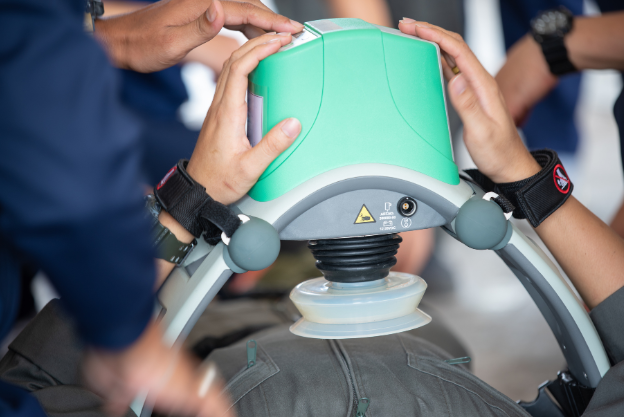
To ensure consistent and high-quality CPR, hospitals and emergency medical services (EMS) are increasingly using mechanical chest compression devices. These devices are designed to deliver chest compressions at the correct rate and depth, maintaining the quality of compressions over extended periods without fatigue.
One of the significant advantages of mechanical chest compression devices is their ability to provide continuous compressions during transport or in challenging environments. This capability is particularly useful for EMS providers who need to perform CPR while moving a patient to a hospital.
Studies have shown that mechanical chest compression devices can improve survival chances and result in better neurological outcomes compared to manual compressions. These devices help maintain a consistent compression rate and depth, which are critical factors in effective resuscitation.
Proper training is essential for using these devices effectively. Healthcare providers must be familiar with the operation and limitations of mechanical chest compression devices to ensure they are used correctly in emergency situations.
By adopting mechanical chest compression devices, healthcare systems can enhance the quality of CPR provided to cardiac arrest patients, ultimately improving survival rates and outcomes. These devices perform cardiac massage, a crucial component of effective chest compression.
Mobile Apps for CPR Instructions
Mobile apps that provide CPR instructions have revolutionized the way people learn and perform CPR. These apps provide on-the-go access to educational resources and real-time guidance, making it easier for lay rescuers to respond effectively in emergencies.
Many CPR apps offer interactive features, such as step-by-step instructions, videos, and simulations, to enhance learning and retention. For example, a digital app was added to help users learn hands-only CPR, simplifying the process and encouraging more people to take action during a cardiac emergency.
Augmented reality (AR) technology takes CPR training to the next level by providing real-time visual aids and guidance. AR can overlay instructions and prompts onto the real-world environment, helping users perform CPR more accurately and confidently.
These apps can also serve as valuable tools for maintaining proficiency. They often include reminders and refresher courses to ensure users stay up-to-date with their skills. By integrating app-based training into CPR education, individuals can access resources and practice opportunities anytime, anywhere.
Overall, mobile apps for CPR instructions are an essential tool for increasing bystander CPR rates and improving outcomes for cardiac arrest patients. By making CPR education more accessible and engaging, these apps empower more people to respond effectively in emergencies.
Ethical Considerations
The only absolute contraindication to CPR is a valid DNR order or other advanced directive. Medical professionals who knowingly disregard a DNR order may face professional reprimands or legal action. DNR bracelets serve as immediate indicators of a person’s wishes regarding resuscitation in emergencies.
Continual training for medical staff on the importance of DNR orders can help prevent accidental resuscitations. Public awareness campaigns on DNR orders can also help community members make informed decisions during emergencies.
Medical futility is another important consideration. Performing CPR is considered a relative contraindication if the physician believes that the intervention would be medically futile. This means that, in certain circumstances, CPR may not be recommended. In such cases, the decision to withhold CPR should be made based on the patient’s overall prognosis and quality of life.
By understanding these legal and ethical considerations, rescuers can make informed decisions and provide appropriate care during cardiac emergencies.
Summary
In summary, understanding and performing high-quality CPR is crucial for improving outcomes in cardiac emergencies. Timely intervention with appropriate chest compressions, rescue breathing, and defibrillation can significantly increase the chances of survival. Age-specific techniques for adults, children, and infants ensure that CPR is tailored to the individual’s needs, enhancing its effectiveness.
High-quality CPR involves maintaining a consistent compression rate and depth, minimizing interruptions, and avoiding excessive ventilation. Compression-only CPR is a valuable option for lay rescuers, simplifying the process and encouraging more people to take action. Advanced airway management and technological aids, such as mechanical chest compression devices and mobile apps, further enhance the quality of resuscitation efforts.
Post-cardiac arrest care, including targeted temperature management and comprehensive neurological assessment, is essential for optimizing recovery and preventing secondary complications. Recognizing and addressing potential complications of CPR, such as rib fractures and gastric insufflation, ensures that lifesaving efforts are both effective and safe.
CPR training and certification are vital for both laypeople and healthcare professionals. Continuous education and practice, supported by technological advancements, can help maintain proficiency and confidence in performing CPR. Understanding the legal and ethical considerations surrounding CPR ensures that rescuers make informed decisions and provide appropriate care.
By being prepared and knowledgeable about CPR, individuals can make a significant difference in cardiac emergencies, potentially saving lives and improving outcomes. Remember, every second counts, and your actions can make all the difference.
Frequently Asked Questions
When should I perform CPR?
Perform CPR on an unresponsive individual who is not breathing normally or only gasping, and check for a pulse if the person is not breathing. If there's no pulse, start CPR immediately after calling for emergency assistance.
What is the compression-to-breath ratio for adult CPR?
The recommended compression-to-breath ratio for adult CPR is 30:2, with 30 chest compressions followed by 2 rescue breaths. This ratio helps maintain blood flow to the brain and other vital organs while providing necessary ventilation.
How does CPR differ for children and infants?
When performing CPR on children, you should use one or both hands for compressions with a depth of 1.5 to 2 inches, while for infants, use two fingers for compressions with a depth of around 1.5 inches and ensure the head is in the 'sniffing position' for rescue breaths. This will help you adapt your technique based on the age of the child you are assisting.
What are the benefits of compression-only CPR?
Compression-only CPR, also known as hands-only CPR, is beneficial for untrained bystanders or those who are unwilling to perform rescue breaths. It involves continuous chest compressions at a rate of 100 to 120 per minute, ensuring that blood flow is maintained. This method is simple, reduces barriers to action, and remains effective in the initial minutes of cardiac arrest.


